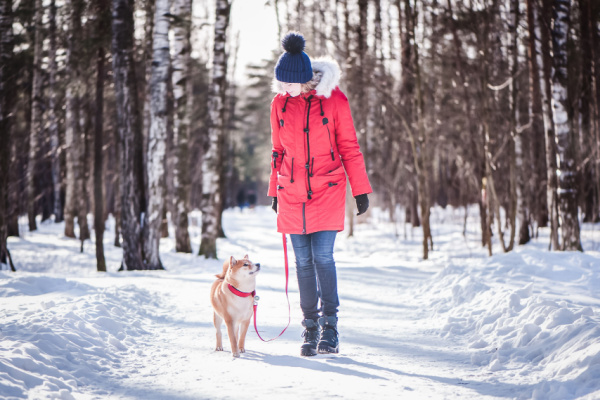Some winter days, dog walks can feel like more of a chore than a good time. That’s kind of the point behind January’s designation as Walk Your Dog Month. During these coldest and shortest days of the year, we all need an excuse to jazz up the daily stroll with the pup and get outside regularly with our pets (and it’s a great New Year’s resolution, too).
Here are some tips to help reinvigorate your routines and focus on good dog-walking behaviors, along with some great gear to make your walks healthy, fun, and safe, from Rover.com.
1. Master good dog-walking form
Need a challenge to get moving? This January could be your chance to hone your walking form! An ideal walk sees your dog trotting beside or slightly behind you, without tugging or pulling ahead—but it can take some work to get there.
For heavy pullers, a good place to start is a no-pull harness. No-pull harnesses are designed to make it hard for your dog to tug on the leash with any real force. They typically do this either by placing the leash attachment point at the front of the chest instead of the back or by gently tightening around the torso like a martingale collar.
Once you’ve got a good handle on your dog’s movements, start practicing positive reinforcement. Reward your doggo with a treat when they’re walking by your side to keep them in stride with you (low-calorie training treats and a treat pouch can help), and don’t shout or yank the leash if your pup breaks form. It sounds like a small adjustment, but it can make a huge difference in the quality of your walks.
You’ll also want to use confident body language—head up, shoulders back. Your dog is watching you for cues, so show them you know what’s up.
Need more help? You may want to consult a professional dog trainer.
2. Get a leash you love and use it well
It might feel like a small thing, but having a leash you love can make a big difference in the quality of your walks. Try a hands-free option so you can bring your morning coffee, or if you’re walking multiple pups, give a double-dog leash a shot to free up a hand for treat-training. Or maybe it’s the mildew smell of a wet leash that you dread—in which case, try a waterproof collar and leash combo.
You can also concentrate on practicing good form with your new leash, which means keeping it short but not too tight—just enough to discourage your dog from bolting, dawdling, or wandering.
3. Set some fun exercise goals
Setting activity goals isn’t for everyone—but for those who enjoy marking milestones, deciding on some metrics for dog-walk success can help. Maybe you’d like to help an overweight pup lose a little weight, or you’re hoping to tire a high-energy dog to cut back on chaos around the house. Tracking your progress against a set of goals can offer motivation when the weather is dreary.
One unusual tool that’s keeping some pet parents moving with their pups? Dog fitbits, which can do everything from tracking your pup’s steps and distance covered to monitoring sleep quality and scratching. Some models show you how you and your pup stack up against neighborhood leaderboards, while others are all about GPS-tracking and safety.
4. Waterproof yourself and your pup
It’s hard to say whether the cold or the damp of January is worse. A good coat for both you and your pup can take the misery off a wet, chilly walk. Not all dogs need clothes, but for some—especially small breeds and senior dogs—an extra layer can restore enthusiasm for a rainy outing. And it’s a lot more fun to walk a happy pup than a reluctant one. (For restoring human enthusiasm? Try a set of rechargeable hand warmers.)
Dog rain jackets can also minimize post-walk drying and cleanup, since they keep not only rain but also mud off your dog’s belly and sides. Together with a good dog doormat that can double as drying cloth and a paw-cleaner, they can shave a huge chunk of time off reentry.
Finally, for the double-coated and extra-fluffy pups, you can try a dog blow dryer. It can get your pup furniture-ready in minutes, and unlike human hair dryers, it’s both safe and powerful enough to get the job done fast.
5. Light up the night (or the early morning)
January days are short, and it can feel like most of your dog walking is done in darkness. Light-up and reflective gear is a good safety precaution that helps other walkers, cyclists, and drivers see your dog before they’re on top of you—which can improve your pup’s peace of mind too.
6. Change up your route
To make walks more fun for you and your dog, rove a little—travel off the beaten path by taking your dog on different routes, going to cool places like the dog park or a friend’s house, and taking walks with buddies.
You can also try making walks practice for some bigger expeditions. For example, try a dog hiking backpack that lets your pup carry some of their own load. Or maybe you need a way to get your pup to more interesting walking locations—in which case you can try a backpack that lets you carry your dog.
However you do it, walking your dog—this month and year-round—is one of the easiest ways to bond with your pet and get the mutual benefit of exercise. Above all, enjoy the time together!
—
Photo Credit: WildStrawberry / Shutterstock.com
